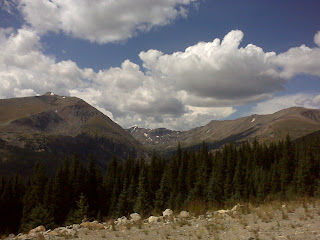It was kind of a watershed day today. On a cool but beautiful day we managed to get up and over Hoosier Pass, our last crossing of the Continental Divide and several thousand feet higher than any other pass we have surmounted. The first 22 miles from Silverthorne to about 4 miles below the top of the pass were a steady but manageable climb. The route rose 2,800 feet in elevation from Silverthorne to the top, and it seemed like 2,000 feet of it were contained in the last 4 miles. Those last few miles were probably the hardest we've encountered, partly because they were well above 10,000 feet, where the air begins to get thin (even for those of us who live at elevation). A couple of times I thought we were going to have to get off and push the tandem, but - despite coming close a couple of times - we did not stall out. We were rewarded for the hard climb by beautiful views from the top of the pass. We met a very nice woman on top who took numerous pictures of us in front of the sign
The weather forecast today wasn't great (50% chance of showers/thunderstorms) but the storms held off until we had ended the day's ride (once again). As we rolled into Fairplay the storm clouds followed closely behind us and we were thankful that we were no longer on the pass, where lightening strikes are more likely.
I was pretty sure this situation was going to happen at some point on this trip but I didn't think it would occur in the way it did. As we left Silverthorne we had to climb a very steep set of "switchbacks" on the bike path, as it wound its way up to the top of the dam at Lake Dillon (a reservoir created by the building of the dam on the Blue River). As we were struggling uphill, obviously in the anaerobic "red zone" (breathing at max), a guy and his buddy on sub-18 pound bikes pulled up along side us. He immediately attempted to chat us up about our trip, the brand of tandem we were riding (he had one too, made by a different frame builder) and the fact that he had seen us the day before yesterday riding along Green Mountain Reservoir. I could not even attempt to talk to him but Penny at least tried. But it should have been obvious to the guy (especially because he also rode a tandem) that we were in a state of major oxygen deprivation and could not spare two extra syllables. All I could think of was: can't you wait until we get to the top of the dam to have this conversation? But no, he was oblivious to our pulmonary distress. So I ignored him - I had no choice. The other day I had told Penny that I thought we would have this happen to us, but I assumed it would be a well-meaning but clueless tourist leaning out a car window as we staggered up a pass. Instead, it was a well-meaning but clueless cyclist who failed to appreciate: (a) the fact that we were on a tandem, which are notoriously heavy and slow going uphill (even though he also had a tandem); (b) our age; and (c) the load we were pulling. Clearly, some people are born without any common sense.
On a positive note, outside of Frisco, CO, we ran into a local guy who - despite also riding on a sub-18 pound bike - was very helpful in helping us negotiate the maze of bike path options between Silverthorne and Frisco. He was patient enough to wait for us in order to lead us through the most confusing set of turns (the pathways are numerous and not often well-marked) and allow us to find the main route to Breckenridge. So I have concluded that only 1/2 of the cyclists here are doofuses.
Sent from my Verizon Wireless BlackBerry









